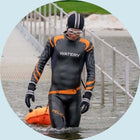Solutions for water in the ear:
Removing the sensation of water inside the ear is not actually very difficult. There are many methods to remove it. The most commonly used methods to remove water from the ear after bathing or swimming are either to:
- Hold your nose and “blow out” (equalize pressure)
- Lie down with your ear on a warm pillow. After 20 minutes, the water should hopefully drain out due to gravity
- Tilt your head with the ear containing water downward and gently tap the other side of your head
- Jump lightly in place
- Use water-absorbent cotton available at the pharmacy to soak up the water
- Insert a piece of cotton into the ear, which will absorb the water
If the above five options do not work immediately, many people, including our customers, have had great success with our Mack's Dry-n-clear Ear Drying kit. This kit has been specially developed by one of the leading American ear doctors. You simply drip it into your ear, and then it dries out the excess water in the ear canal (and possibly removes any blockage). It may sound magical, but it actually works right away. Plus, it's priced at only 9,25 EUR.
Try the Ear Drying kit here.

Mack´s ear drying kit against water in the ears - Dry-n-clear
4.62/5
Based on 8 reviews
Causes of having fluid in your ear:
The reason you have fluid in the middle ear is due to reduced function of the Eustachian tube, which is a connection between the middle ear and the throat inside the ear.
The cause of this can be that you recently had an infection, allergy, or have been exposed to very cold conditions, as the “risk” is much higher in these situations. Especially if you go swimming or to the beach immediately afterward.
A good idea is to avoid going outside in the cold wind without a hat, as this significantly increases the risk.
Usually, children in school age or in kindergarten are the ones who experience water in the ear the most because they are more frequently exposed to colds in contact with other children.
What not to do to remove the water:
Many people believe that the best and easiest way to remove water or blockages from the ear is to stick a finger or a cotton swab in as far as possible.
You should stop doing this immediately as it can be dangerous and can damage the ear. Instead, follow the three best practices mentioned above, as they work and are recommended by doctors.

If the water remains in the ear after approximately 3-6 months, and you have tried the above solutions, you should probably visit your personal doctor.
In fact, every 12 years or so, it's recommended to have your ears rinsed by a doctor. If you haven't done so and the water still remains in the ear, it may indicate that something else is wrong.
Some people find out at the doctor's office that the water is due to either:
- Mold in the ear
- Bacteria in the middle ear
- Ear canal eczema
If you are unsure, it's best to consult your doctor. At the doctor's office, your ear will be rinsed with a mini vacuum, removing both earwax and the water inside the ear.
Three quick facts about fluid in the middle ear:
- Fluid in the middle ear refers to when fluid is behind the eardrum
- The fluid inside the ear usually goes away on its own, and as a rule, treatment is not necessary. Only if it hasn't gone away after about a week
- The fluid can be thin, thick, or mucous
How to avoid water in the ear in the future:
The ultimate solution:
Water in the ear can be really annoying, especially if you get it after every trip to the swimming pool or in the water. So, you'd probably prefer to find a way to avoid it in the future, right?
Fortunately, there are several solutions for this.
The best way to avoid water in the ear in the future is to use an ear dryer after your water activities. We have found that Mack's Ear dryer is the best option, which is why we have chosen to offer it in our assortment.
The unique thing about it is that in under 1 minute, you, your child, or anyone else can air-dry the entire ear canal, ensuring you never have that feeling of blockage in your ear again.
You can find Mack's Ear dryer for removing blockages/water in the ear here.
4.6/5
Based on 5 reviews

Mack´s ear dryer against water in the ears
Earplugs can protect you from “swimmer's ear” and problems:
The solution to the above “problem” with the ears could very well be earplugs. In fact, that's what they're made for – to keep water out of the ears. However, normal earplugs will fall out, and they won't be able to keep water out. Special earplugs for swimming, on the other hand, can.
In general, it's a good idea to use earplugs in your ears when you swim. This way, you can prevent water from getting into your ears in the first place.
The best earplugs on the market, after trying all the options in our assortment, are definitely these Swimears earplugs. They automatically shape themselves to fit your individual ear. There's both an adult model here and a junior model here.
If you're looking for a more cost-effective alternative, we have developed these Active earplugs in three different colours that have an ergonomic shape, providing a snug fit.
We know from personal experience that a good pair of earplugs can work wonders to avoid water in the ears and thus increase the joy of swimming.
In any case, use earplugs when you go to the swimming pool right after being out in the cold and wind, having a cold, or being sick, and you'll be on the safe side.
However, the best solution, no matter what, is to use the Ear dryer mentioned above. With it, you can be completely sure to avoid this problem in the future.
And if it still happens, the fastest and cheapest solution for water/blockages in the ear right now is this Ear drying kit, which is the world's most used. All three or four products should be in the hands of every swimmer who frequently deals with this annoying issue of water in the ear. A good swim cap along with the earplugs can completely protect you from water, as they cover the ear canal and hold them in place.





















![[Solved] Earplugs/Water in the Ear - How do I remove it?](http://watery.ie/cdn/shop/articles/Design_uden_navn_46_520x500_0b9bdff8-cb71-46dd-ad08-4572c12eb0eb.png?v=1765285453&width=1300)




